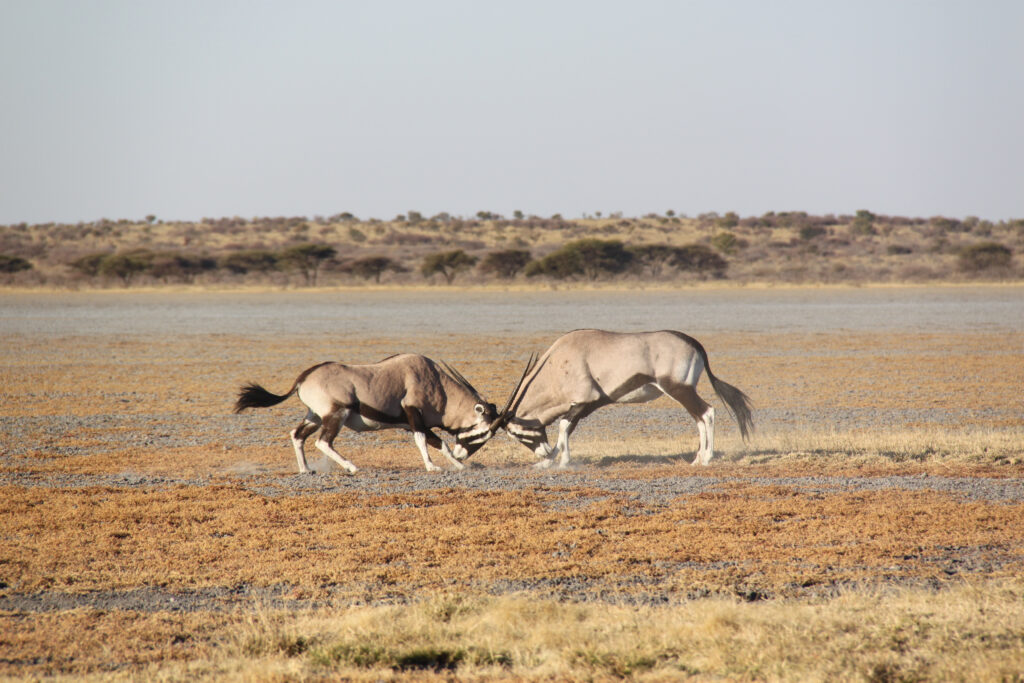Nxai Pan National Park: Botswana’s Hidden Safari Gem
Nestled within the northeastern corner of Botswana’s Kalahari Desert, Nxai Pan National Park stands as a destination unlike any other. This pristine safari haven is a striking blend of salt pans, wide-open grasslands, ancient baobabs, and a rich tapestry of wildlife, creating a mesmerizing landscape that leaves every visitor captivated. For travellers craving an authentic safari experience far from the crowds, Nxai Pan offers a chance to immerse oneself in the wild heart of Africa, experiencing both the raw beauty of nature and the rich cultural history of the region.
Established in 1970 and expanded in the early 1990s to include the Nxai Pan and the iconic Baines’ Baobabs, Nxai Pan National Park now covers approximately 2,580 square kilometers. The park’s unique geography and varied habitats make it a place of surprising biodiversity. Throughout the seasons, Nxai Pan reveals its unique character—sometimes as a stark, almost alien landscape of cracked salt pans under a bright sun, and at other times, a lush oasis alive with migratory birds and thriving wildlife.
The Enigmatic Salt Pans of Nxai Pan National Park
Nxai Pan National Park is most famous for its vast salt pans, which were once ancient lake beds. Over millennia, these lakes dried up, leaving behind expansive salt flats that shimmer white under the desert sun. This stunning, almost surreal landscape gives the park its unique character, presenting a stark contrast to the neighboring grassy plains and dense acacia woodlands. Visitors who arrive in the dry season from May to October witness the pans in their most surreal state—cracked and chalky, stretching as far as the eye can see.
During the rainy season, from November to April, these salt pans transform into shallow lakes, attracting waterbirds, including flamingos, pelicans, and other migratory species that flock to the temporary oasis. This time of year, Nxai Pan National Park changes from a stark desert to a vibrant, lively landscape teeming with life, as zebra, springbok, and wildebeest arrive to graze on the fresh vegetation sprouting up around the newly formed lakes. The seasonal transformation makes Nxai Pan a paradise for photographers and nature lovers alike, who are captivated by the endless skies, dramatic thunderstorms, and lush new growth that turns this arid land into a veritable Eden.
Wildlife of Nxai Pan National Park: A Symphony of Life
Despite its arid setting, Nxai Pan National Park is a rich ecosystem supporting an impressive diversity of animals, especially during the rainy season when migratory herds arrive in the park in search of fresh grazing grounds. At the heart of this migration is Botswana’s second-largest zebra migration, where thousands of zebras make their way to Nxai Pan, traveling from the Okavango Delta in an extraordinary feat of endurance and survival. This incredible migration, stretching hundreds of kilometers, is one of the most dramatic events in the region and a highlight of any visit during the green season.
During this time, predators like lions, cheetahs, and hyenas are never far behind the herds, lying in wait for opportunities to hunt. The interaction between predator and prey, set against the stunning background of the pans, is a quintessential African experience. Observing these animals in their natural habitat, from the stealth of the cheetah to the patience of the lion, visitors can witness the intricate dance of life that defines Nxai Pan National Park.
Beyond the migrating herds, Nxai Pan also supports a range of resident animals that have adapted to the harsh desert conditions. Springboks, oryx, and the rare brown hyena are some of the resilient species found here year-round. Elephants and giraffes are also spotted in the park, along with smaller but equally captivating animals like bat-eared foxes and aardwolves. Birdwatchers will be delighted by the array of bird species, especially during the wet season when the park becomes a haven for waterbirds, raptors, and a host of other species.

The Ancient Baobabs of Nxai Pan National Park
One of the most iconic and recognizable features of Nxai Pan National Park is the cluster of massive, centuries-old baobab trees known as Baines’ Baobabs. Named after the British explorer and artist Thomas Baines, who painted them in 1862, these seven colossal baobabs stand on a small island on the edge of Kudiakam Pan. The towering trees have an almost mystical quality, with their thick trunks and twisted branches rising against the flat salt pan backdrop. Baines’ Baobabs have become a symbol of the resilience and enduring beauty of the African landscape, serving as silent witnesses to the passing centuries.
Visiting Baines’ Baobabs is a highlight for many travelers to Nxai Pan National Park, offering a sense of timelessness and tranquility rarely found elsewhere. As the sun sets, casting long shadows and turning the trees into silhouettes, the scene becomes even more otherworldly. Photographers find these ancient giants irresistible, as they provide a focal point in the wide, open landscape that makes Nxai Pan so unique. Baines’ Baobabs offer not only a stunning view but also a connection to the history and culture of early explorers who once traversed these lands, seeking to document the beauty and mystery of Africa.
Nxai Pan National Park Throughout the Seasons
Each season in Nxai Pan National Park offers a different perspective on the park’s landscape and wildlife, making it a year-round destination for intrepid travelers. During the dry season, which runs from May to October, the lack of rainfall forces animals to gather around permanent water sources, offering excellent opportunities for game viewing and predator sightings. As water becomes scarcer, lions, cheetahs, and even jackals are frequently seen hunting near waterholes, giving visitors a thrilling view of the circle of life.
The dry season also brings cooler temperatures, making it a comfortable time for exploration and game drives. This season’s clear, sunny skies offer brilliant light for photography, enhancing the stark beauty of the pans and the striking contrast between the landscape and its inhabitants. For those seeking to experience the raw beauty of Nxai Pan National Park and its wildlife at close range, the dry season is ideal.
The green season, from November to April, transforms Nxai Pan in a way that few visitors expect. The arrival of the rains brings life to the park, with greenery sprouting across the plains and the salt pans filling with water. Thousands of zebra make their way into the park, accompanied by wildebeest, and springbok, creating a stunning tableau of wildlife in motion. This migration attracts numerous predators, turning the park into a stage for dramatic encounters between hunter and prey. Though temperatures can be high during this season, the spectacle of life in Nxai Pan National Park is unparalleled.
Luxury and Comfort in Nxai Pan National Park
Although Nxai Pan National Park is remote and wild, visitors need not forgo comfort. A range of lodges and campsites cater to different tastes and budgets, offering accommodations that are luxurious yet in harmony with the natural surroundings. Safari camps within the park provide comfortable accommodations with easy access to the best wildlife areas, allowing guests to wake up to the sounds of the wild, step right into game drives, and unwind with a sundowner overlooking the vast pans.
Many of the park’s lodges blend luxury with sustainability, emphasizing eco-friendly practices to preserve the fragile ecosystem of the Kalahari. Accommodations often include comfortable beds, en-suite bathrooms, and sometimes even private plunge pools where guests can relax after a day of adventure. In the evenings, guests can gather around a campfire under the African stars, sharing stories of the day’s sightings and immersing themselves in the timeless magic of the Kalahari night.
Getting to Nxai Pan National Park
Accessing Nxai Pan National Park is part of the adventure. The park is reachable by road, though a 4×4 vehicle is essential due to the challenging terrain. For those looking for a quicker and more scenic route, light aircraft flights can be arranged from major hubs in Botswana, such as Maun or Kasane. The journey is rewarding, with aerial views providing a breathtaking perspective on the park’s salt pans, grassy plains, and winding animal trails.
For the best experience, visitors are encouraged to travel with knowledgeable guides or safari operators who are familiar with the park’s seasonal changes and wildlife habits. These guides provide insights into the park’s ecology, history, and local culture, enhancing the safari experience and ensuring that travelers can safely navigate the park’s rugged terrain.
Nxai Pan National Park: A Journey into Botswana’s Wilderness
More than just a destination, Nxai Pan National Park is a journey into the soul of Botswana’s wild and untamed landscapes. From the shimmering salt pans to the thriving wildlife, every moment in Nxai Pan unfolds like a chapter in an epic African story, one where each season brings new challenges, new life, and new beauty. For those seeking a deeper connection with nature, a place where the land seems to breathe with ancient rhythms, Nxai Pan offers an experience that is as humbling as it is inspiring.
Visitors to Nxai Pan National Park leave with more than memories; they carry with them a sense of awe and respect for a land that has remained largely untouched by time, a place where the earth and its creatures continue to live as they have for centuries. As travellers stand before the towering baobabs, gaze across the salt pans, or witness the powerful drama of predator and prey, they become a part of Nxai Pan’s timeless story, forever marked by the magic of Botswana’s wilderness.
In a world that often feels increasingly tame and connected, Nxai Pan National Park offers a rare opportunity to experience something truly wild and profound. This park invites all who visit to step off the beaten path and into a place where nature reigns supreme, a place where every sunrise and sunset reveals new wonders, and where the spirit of Africa is felt in every breeze, every animal call, and every ripple in the salt pans. For those willing to venture into its rugged heart, Nxai Pan promises an unforgettable journey into the true essence of the African wilderness.
Ready to experience Botswana in all its breathtaking glory? Contact us, and let us guide you on an unforgettable journey to discover the wild heart of Africa!
What is the best time to visit Nxai Pan National Park?
The best time to visit Nxai Pan depends on your interests. For wildlife viewing, the dry season (May to October) is ideal as animals gather around water sources. The green season (November to April) is perfect for witnessing the zebra migration and lush landscapes, though temperatures are higher.
What wildlife can I expect to see in Nxai Pan National Park?
Nxai Pan is home to a wide range of wildlife, including large herds of zebra, springbok, oryx, and wildebeest. Predators such as lions, cheetahs, and jackals are commonly spotted, especially during the dry season. Birdwatchers can also enjoy a variety of migratory birds during the rainy season.
What accommodations are available in Nxai Pan National Park?
The park offers several accommodation options, from luxury lodges and campsites within the park to more budget-friendly options nearby. Many lodges and camps provide immersive safari experiences with comfortable amenities, and some offer guided game drives and nature walks.
How do I get to Nxai Pan National Park?
Nxai Pan is accessible by 4×4 vehicle, with road access from Maun, a major town in Botswana. For a quicker and scenic option, light aircraft flights are available from major hubs like Maun or Kasane, which can take you directly to airstrips near the park.


You must be logged in to post a comment.